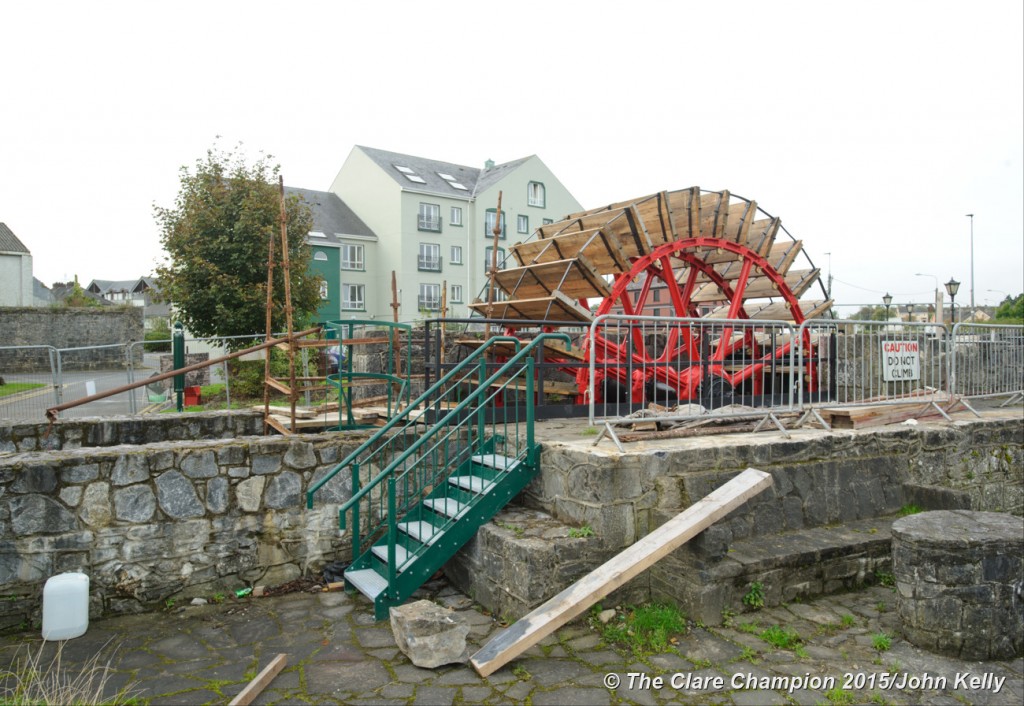AN HISTORIC Ennis project, which certainly isn’t run of the mill, is set to get its wheel in motion in the coming weeks. Restoration work on the 19th century mill wheel at the Maid of Éireann roundabout, with the potential for producing renewable energy, is expected to be completed shortly.
However, don’t expect any reduction in electricity bills with an estimated cost of more than €60,000 to make the commercial production of electricity worth €2,203 a year viable.
That has not stopped calls for the private sector to get involved in making the potential for renewable energy generation by harnessing the power of the River Fergus at the site a reality.

The Ennis mill wheel has been restored in a project undertaken by the Ennis Civic Trust with Ger Dollard, director of services at Clare County Council, confirming that the restoration is expected to be finished next month.
Ennis Councillor Johnny Flynn believes the project has the potential for creating green energy and he says the €60,000 price tag could be met by private investors.
“This historic wheel has been idle for the longest time and it’s great to see the work of the council and the Civic Trust in restoring it and I think it has potential,” he said.
Mr Dollard told this week’s meeting of Ennis Municipal District councillors that the proposal “didn’t make financial sense”, adding, “if it’s something that somebody in the private sector wishes to get involved with, we would be quite happy to talk with them.”
He stated that the Ennis Civic Trust have done a lot of work with the Ennis mill wheel, saying, “when it is finished, it will be a very attractive heritage project for the town”.
At the moment, the Limerick Clare Energy Agency (LCEA) are considering a proposal to generate a small quantity of electricity from the wheel to power lights, a display and monitoring equipment.
According to Pat Stephens of the LCEA, “The potential for renewable energy (electricity) generation and export to the grid at the Ennis mill wheel was examined as part of the overall refurbishment proposals in early 2013. The mill wheel is recognised as a suitable site for renewable energy potential in the Clare Renewable Energy Strategy and Clare Micro Hydro Study. Following an initial potential assessment by LCEA, a detailed hydrological and environmental assessment was conducted. The results of the studies showed that the electricity generation potential at the mill wheel is significantly constrained by the present tail race culvert, fish protection water flow requirements, flood protection and the design of the original wheel. There is also some concern expressed about the need to protect the general public if a working turbine was installed.
“The annual electricity generation capacity under present conditions would be approximately 26,286kWh per annum with a value under the Renewable Energy Feed in Tariff scheme of €2,203 . The cost of civil, mechanical, electrical and grid connections associated with a turbine at the site, including measures to protect the public, are estimated to be in excess of €60,000 making a ‘commercial’ project unviable.
“A proposal to generate a small quantity of electricity, less than 1.5kW to power lights, a display and possibly some monitoring equipment is being considered at present. The environmental and hydrological data on river height and flows etc will be made available to local schools and third-level institutions.”
By Jessica Quin
A native of Ennis, Colin McGann has been editor of The Clare Champion since August 2020. Former editor of The Clare People, he is a journalism and communications graduate of Dublin Institute of Technology.


